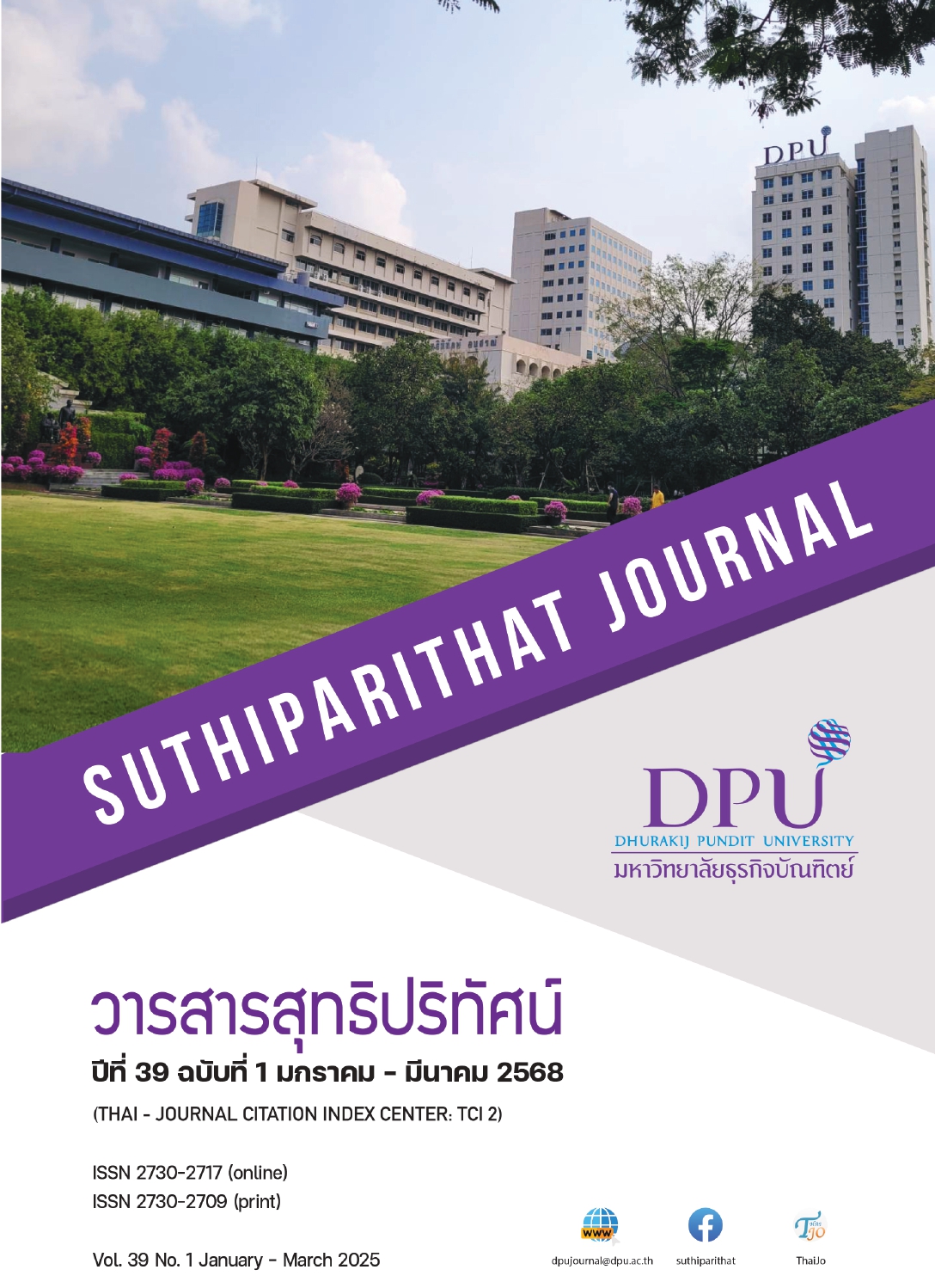ประสิทธิภาพการบริการที่ส่งผลต่อความพึงพอใจผู้ใช้บริการสถาบันการเงินภาครัฐบาล
คำสำคัญ:
ประสิทธิภาพการบริการ, ความพึงพอใจผู้ใช้บริการ, สถาบันการเงินภาครัฐบาลบทคัดย่อ
งานวิจัยเรื่องนี้มีวัตถุประสงค์เพื่อสำรวจประสิทธิภาพการบริการที่ส่งผลต่อความพึงพอใจผู้ใช้บริการสถาบันการเงินภาครัฐบาล ในการศึกษานี้เก็บรวบข้อมูลโดยการแจกแบบสอบถามกับกลุ่มตัวอย่างที่เป็นผู้ใช้บริการสถาบันการเงินภาครัฐบาล จำนวน 385 ท่าน ที่วิเคราะห์ข้อมูลด้วยสถิติการวิเคราะห์การถดถอยพหุคูณ ผลการศึกษา พบว่า สมมติฐานได้รับการสนับสนุนคือ ประสิทธิภาพการบริการมีผลต่อความพึงพอใจผู้ใช้บริการสถาบันการเงินภาครัฐบาล อย่างมีนัยสำคัญทางสถิติที่ระดับ 0.001 ซึ่งเป็นที่น่าสังเกตว่า ตัวแปรประสิทธิภาพการบริการที่มีผลต่อความพึงพอใจผู้ใช้บริการสถาบันการเงินภาครัฐบาลมากที่สุดคือ การให้บริการอย่างก้าวหน้า (Beta = 0.497) การให้บริการอย่างต่อเนื่อง (Beta = 0.194) การให้บริการอย่างพอเพียง (Beta = 0.173) ความรวดเร็วทันเวลา (Beta = 0.170) และ การให้บริการอย่างเท่าเทียม (Beta = 0.168) ตามลำดับ ผลการศึกษาครั้งนี้แสดงว่าประสิทธิภาพการบริการทั้งหมดมีผลต่อความพึงพอใจผู้ใช้บริการสถาบันการเงินภาครัฐบาล แต่มีการประเมินในเชิงบวกที่ดีที่สุดคือ ด้านการให้บริการอย่างก้าวหน้า เพราะในสถาบันการเงินของรัฐบาล การให้บริการแบบก้าวหน้าเป็นตัวช่วยในการลดช่องว่างระหว่างการดำเนินงานภาครัฐแบบดั้งเดิมและความคาดหวังที่เปลี่ยนแปลงไปของลูกค้า ซึ่งปัจจุบันมีแนวโน้มที่จะนิยมใช้บริการในรูปแบบดิจิทัลและใช้งานง่ายมากขึ้น ผลการวิจัยชี้ให้เห็นว่าการปรับปรุงบริการให้ก้าวหน้า เช่น การให้บริการธนาคารผ่านมือถือหรือการประมวลผลเอกสารในรูปแบบดิจิทัล สามารถส่งผลดีต่อความพึงพอใจของลูกค้าได้โดยทำให้การเข้าถึงบริการเป็นไปอย่างง่ายและสะดวก
References
Anderson, E. W., & Mittal, V. (2000). Strengthening the satisfaction-profit chain. Journal of Service Research, 3(2), 107-120. https://doi.org/10.1177/109467050032001
Bayly, J., Bone, A. E., Ellis-Smith, C., Tunnard, I., Yaqub, S., Yi, D., Nkhoma, K. B., Cook, A., Combes, S., Bajwah, S., Harding, R., Nicholson, C., Normand, C., Ahuja, S., Turrillas, P., Kizawa, Y., Morita, T., Nishiyama, N., Tsuneto, S., Ong, P., Higginson, I. J., Evans, C. J., & Maddocks, M. (2021). Common elements of service delivery models that optimise quality of life and health service use among older people with advanced progressive conditions: A tertiary systematic review. BMJ Open, 11(12), Article e048417. https://bmjopen.bmj.com/content/11/12/e048417
Berry, L. L., & Parasuraman, A. (1991). Marketing services: Competing through quality. The Free Press.
Biitner, M. J., Brown, S. W., & Meuter, M. L. (2000) Technology infusion in service encounters. Journal of the Academy of Marketing Science, 28, 138-149. https://doi.org/10.1177/0092070300281013
Bitner, M. J., Booms, B. H., & Mohr, L. A. (1994). Critical service encounters: The employee’s viewpoint. Journal of Marketing, 58(4), 95-104. http://dx.doi.org/10.2307/1251919
Bitner, M. J., Booms, B. H., & Tetreault, M. S. (1990). The service encounter: Diagnosing favorable and unfavorable incidents. Journal of Marketing Research, 54(1), 71-84. http://dx.doi.org/10.2307/1252174
Chaturvedi, S. (2021, January 19). The four levels of customer satisfaction. Smartkarrot. https://www.smartkarrot.com/resources/blog/l0kevels-of-customer-satisfaction/
Cochran, W. G. (1977). Sampling techniques (3rd ed.). John Wiley & Sons.
Fornell, C., & Larcker, D. F. (1981). Evaluating structural equation models with unobservable variables and measurement error. Journal of Marketing Research, 18(1), 39-50. https://doi.org/10.2307/3151312
Haque, M. S. (2001). The diminishing publicness of public service under the current mode of governance. Public Administration Review, 61(1), 65-82. https://doi.org/10.1111/0033-3352.00006
Herzberg, F. (1959). The motivation to work. John Wiley & Sons.
Hsiao, C. T., & Lin, J. S. (2008). A study of service quality in public sector. International Journal of Electronic Business Management, 6(1), 29-37. https://www.researchgate.net/publication/26542287_A_Study_of_Service_Quality_in_Public_Sector
Johnston, R. (1995). The determinants of service quality: Satisfiers and dissatisfiers. International Journal of Service Industry Management, 6(5), 53-71. http://dx.doi.org/10.1108/09564239510101536
Jones, T. O., & Sasser, W. E. (1995). Why satisfied customers defect. Harvard Business Review, 73, 88-99.
Kotler, P., & Keller, K. L. (2016). Marketing management (15th ed.). Pearson Education.
Kumar, V., Aksoy, L., Donkers, B., Venkatesan, R., Wiesel, T., & Tillmanns, S. (2001). Undervalued or overvalued customers: Capturing total customer engagement value. Journal of Service Research, 13(3), 297-310. https://doi.org/10.1177/1094670510375602
Luengalongkot, P. (2021). Influence of good governance on service quality a case study of Phanatnikhom Town Municipality, Thailand. Journal of Legal, Ethical and Regulatory Issues, 24(1S), 1-9. https://www.abacademies.org/articles/influence-of-good-governance-on-service-quality-a-case-study-of-phanatnikhom-town-municipality-thailand.pdf
Maslow, A. H. (1943). A theory of human motivation. Psychological Review, 50(4), 370-396. https://doi.org/10.1037/h0054346
Oliver, R. L. (1980). A cognitive model of the antecedents and consequences of satisfaction decisions. Journal of Marketing Research, 17(4), 460–469. https://doi.org/10.2307/3150499
Parasuraman, A., Zeithaml, V. A., & Berry, L. L. (1988). SERVQUAL: A multiple-item scale for measuring consumer perceptions of service quality. Journal of Retailing, 64(1), 12-40. https://www.researchgate.net/publication/200827786_SERVQUAL_A_Multiple-item_Scale_for_Measuring_Consumer_Perceptions_of_Service_Quality
Rust, R. T., & Oliver, R. L., (2000). Should we delight the customer. Journal of the Academy of Marketing Science, 28(1), 86-94. https://doi.org/10.1177/0092070300281008
Saxena, S. (2023, September 25). Customer delight – Meaning & importance [+5 tips to delight customers]. Merren. https://merren.io/a-guide-to-customer-delight/
Vargo, S. L., & Lusch, R. F. (2004). Evolving to a new dominant logic for marketing. Journal of Marketing, 68(1), 1–17. https://doi.org/10.1509/jmkg.68.1.1.24036
Wibowo, E. B. (2020). Debtor behavior on loyalty: The role of timeliness and service convenience in Banking Industry. International Journal of Education and Social Science Research, 3(5), 88-98. https://doi.org/10.37500/ijessr.2020.3507
Yusoff, W. F. W., & Alhaji, I. A. (2012). Corporate governance and firm performance of listed companies in Malaysia. Trends and Development in Management Studies, 1(1), 43-65. https://www.researchgate.net/publication/291035589_Corporate_governance_and_firm_performance_of_listed_companies_in_Malaysia
Zeithaml, V. A., Berry, L. L., & Parasuraman, A. (1993). The nature and determinants of customer expectation of service. Journal of the Academy of Marketing Science, 21, 1-12. http://dx.doi.org/10.1177/0092070393211001
Zeithaml, V. A., Parasuraman, A., & Berry, L. L. (1990). Delivering quality service: Balancing customer perceptions and expectations. The Free Press.
Downloads
เผยแพร่แล้ว
How to Cite
ฉบับ
บท
License
Copyright (c) 2025 มหาวิทยาลัยธุรกิจบัณฑิตย์

This work is licensed under a Creative Commons Attribution-NonCommercial-NoDerivatives 4.0 International License.
เนื้อหาและข้อมูลในบทความที่ลงตีพิมพ์ในวารสารสุทธิปริทัศน์ ถือเป็นข้อคิดเห็นและความรับผิดชอบของผู้เขียนบทความโดยตรงซึ่งกองบรรณาธิการวารสาร ไม่จำเป็นต้องเห็นด้วย หรือร่วมรับผิดชอบใดๆ
บทความ ข้อมูล เนื้อหา รูปภาพ ฯลฯ ที่ได้รับการตีพิมพ์ในวารสารสุทธิปริทัศน์ ถือเป็นลิขสิทธิ์ของวารสารสุทธิปริทัศน์หากบุคคลหรือหน่วยงานใดต้องการนำทั้งหมดหรือส่วนหนึ่งส่วนใดไปเผยแพร่ต่อหรือเพื่อกระทำการใด ๆ จะต้องได้รับอนุญาตเป็นลายลักษณ์อักษรจากวารสารสุทธิปริทัศน์ก่อนเท่านั้น






